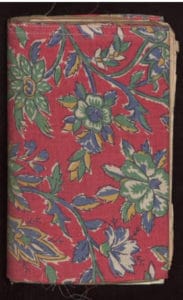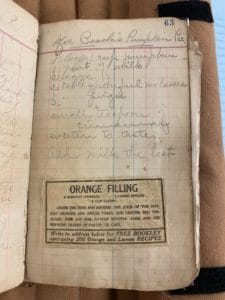“From the Classroom” is a series that features some of the great work and research from students who visit our collections. Below is a blog by Alexa Starry from Dr. Jennifer Burek Pierce’s class “History of Readers and Reading” (SLIS:5600:0001)
Stepping into the life of Julia Booker Thompson
Alexa Starry
Cookbooks are a wonderful way to share things through time, heritage, and generations – recipes, ideas, home remedies, you name it. They are an incredibly valuable source of information for historical narratives. When you follow a recipe that was handwritten with care by someone before you, you’re keeping a piece of that person alive. Cooking can be a beautiful, shared experience throughout history, and, in that case, cookbooks can be the blueprint for interpretations of these experiences. They can help shed a light upon the past.
Through Julia Booker Thompson’s 1898 recipe and travel book, we get a glimpse into the daily life of a woman during the nineteenth century. We know she enjoyed trying new recipes, traveled occasionally, and oftentimes looked through the newspaper for home remedies. The details in the journal point to a woman dedicated to running an efficient household, something expected of many middle- and upper-class women at the time.
Julia’s recipe collection ranges from sponge cake to pumpkin pie to potato puffs. She includes a recipe for scalloped tomatoes which consists of tomatoes seasoned with sugar, pepper, salt, and butter, then covered with breadcrumbs and baked. There are also recipes for grape juice, orange filling, ice cream, and soda mixtures. She would often leave notes in the margins of these recipes with brief personal reviews such as “fine” and “good.” Though short, these notes are an impression of Julia’s character, her tastes and thoughts. A few of her recipes are credited to a woman named Ella Churchill, and there are also recipes from an “Aunt Florence,” the namesake behind Julia’s entry of “Aunt Florence’s Chicken Pie and Biscuits.” The preservation of cookbooks like this one give us the chance to recreate ideas, such as meals, in the present day. It is a way to vividly reimagine the past in a modern context.
Some of the most interesting things in the book are the home remedies and newspaper clippings tucked inside, including tips on how to remove mildew, a remedy for poison ivy, how to clean silk with a raw potato, a trick to remove ink stains with a “paste of sweet milk and corn meal,” and a cure for Cholera Infantum that calls for boiled strawberry leaves. These remedies not only provide a glimpse into common ailments that might afflict a household during this time, but also a look into how people were applying their knowledge and resources to fight these afflictions.
Another noteworthy and unique component of the book is that a short portion of it serves as a travel journal. There are notes of a trip to Montreal, followed by a quick journey to St. Paul, as well. It is a look into not only the ordinary home life of Julia Booker Thompson, but also an exciting moment in time for her.
Though we often associate women of the nineteenth century with the home, this little book shows several facets to Julia Booker Thompson. The recipes and reviews show a woman who cared about the food she cooked, and the names with the recipes show a community of women Julia found herself a part of. Paper clippings show someone interested in furthering her knowledge of best practices for a healthy, clean, and efficient household. And the unique travel log shows a woman not just confined to one space. In fact, her recipe and travel book offers a vivid and sensorial look into the past. It has been over a hundred years since Julia wrote in this book, but we are still able to see details of a life lived, of Julia’s life, live on.
Further Reading:
Driver, Elizabeth. “Cookbooks as primary sources for writing history: a bibliographer’s view.” Food, Culture & Society, vol. 12, no. 3, 2009, p. 257+. Gale Academic OneFile. Accessed 3 Mar. 2021.
“Everyday Life & Women in America: C.1800-1920 / from the Sallie Bingham Center for Women’s History & Culture, Duke University, & the New York Public Library.” Marlborough, Wiltshire, England: Adam Matthew Publications, Marlborough, Wiltshire, England, 2006.
Robinson, Jane. Unsuitable for Ladies: An Anthology of Women Travellers. Oxford University Press, 2001.
Wessell, A. “Cookbooks for Making History: As Sources for Historians and As Records of the Past”. M/C Journal, vol. 16, no. 3, Aug. 2013.


